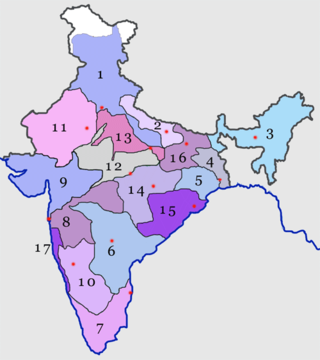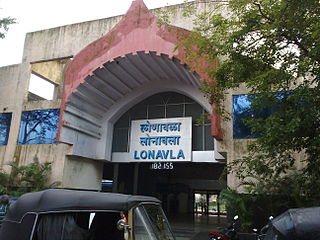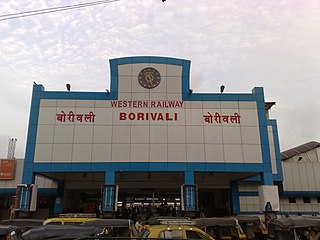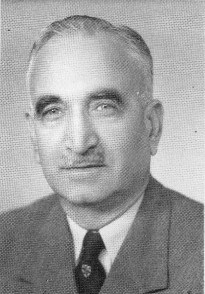
Chhatrapati Shivaji Terminus (officially Chhatrapati Shivaji Maharaj Terminus since 2017, formerly Victoria Terminus (VT), Bombay station code: CSMT (mainline)/ST (suburban)), is a historic railway terminus and UNESCO World Heritage Site in Mumbai, Maharashtra, India.

The Mumbai Suburban Railway consists of exclusive inner suburban railway lines augmented by commuter rail on main lines serving outlying suburbs to serve the Mumbai Metropolitan Region. Spread over 450 kilometres (280 mi), the suburban railway operates 2,342 train services and carries more than 7.5 million commuters daily.

Kurla is a suburb of East Mumbai, India. It is the headquarters of the Kurla taluka of Mumbai Suburban district. The neighbourhood is named after the eponymous East Indian village that it grew out of. It falls under Zone 5, Ward 'L' of the Bombay Municipal Corporation. Its railway station, spelt as Coorla until 1890, is one of the busiest on the Mumbai suburban railway on the central and harbour railway lines of Mumbai as is the Lokmanya Tilak Terminus (LTT) for out-station passenger/express trains.

Colaba is a part of the city of Mumbai, India. It is one of the four peninsulas of Mumbai while the other three are Worli, Bandra and Malabar Hill. During Portuguese rule in the 16th century, the island was known as Kolbhat. After the British took over the island in the late 17th century, it was known as Kolio.

Mumbai Central is a major railway station on the Western line, situated in Mumbai, Maharashtra in an area known by the same name. It serves as a major stop for both local and intercity trains with separate platforms between them. It is also a terminal for several long-distance trains including the Mumbai Rajdhani Express.

Churchgate is an area in the southern part of Mumbai, close to the Arabian Sea. The area is known for its unique architecture consisting of art deco style residential buildings, access to sporting venues, and the business district of Nariman Point.

Prabhadevi railway station is a Railway station junction which connects the Central line to Parel of Mumbai Suburban Railway. It serves the area of Prabhadevi in Mumbai, India. This railway station has two platforms which are of only slow trains halt.

Goregaon ([ɡoːɾeɡaːʋ]) is a suburb of Mumbai city, in the Mumbai Suburban district of India. It has a railway station on the Mumbai suburban railway on the Western Line. An extension of the Harbour Line was completed in 2018 due to which it has regular trains to CSMT. This is in addition to existing trains to Churchgate on the Western Line. Owing to rapid urbanization and the growing population of metropolitan Mumbai, Goregaon, which was once a hilly forest region is now a crowded suburb of Mumbai.

The Western Railway is one of the 19 zones of Indian Railways and is among the busiest railway networks in India, headquartered at Mumbai, Maharashtra. The major railway routes of Indian Railways which come under Western Railways are: Mumbai Central–Ratlam, Mumbai Central–Ahmedabad and Palanpur–Ahmedabad. The railway system is divided into six operating divisions: Ahmedabad, Vadodara, Rajkot, Bhavnagar, Ratlam, and Mumbai WR. Vadodara railway station, being the junction point for the Ahmedabad–Mumbai route and the Mumbai–Ratlam route towards New Delhi, is the busiest junction station in Western Railways and one of the busiest junctions of Indian Railways too, while Ahmedabad Division earns highest revenue followed by Mumbai Division and Vadodara Division. Surat railway station is one of the busiest railway station in Western Railway in non-junction category where more than 180 trains pass per day.

South Mumbai, colloquially SoBo from South Bombay in Indian English, administratively the Mumbai City District, is the city centre and the southernmost precinct of Greater Bombay. It extends from Colaba to Mahalaxmi, Byculla and Mazgaon neighbourhoods, and comprises the city's old and formerly main business localities, making it the wealthiest urban precinct in India. Property prices in South Mumbai are by far the highest in India and among the highest in the world. In terms of Maharashtra Legislative Assembly, the precinct consists of the constituencies of Colaba, Mumbadevi, Malabar Hill and Byculla.

Navy Nagar is a cantonment area in Mumbai, India, and was established in 1796. The area is owned and managed solely by the Indian Navy and entry to this area is highly restricted. Entry and exit points to the area are heavily manned by Naval Police.

The Bombay, Baroda and Central India Railway was a company incorporated in 1855 to undertake the task of constructing railway lines between Bombay to the erstwhile Baroda State, that became the present-day Baroda (Vadodara) city in western India. BB&CI completed the work in 1864. The first suburban railway in India was started by BB&CI, operating between Virar and Bombay Backbay station, a railway station in Bombay Backbay in April 1867.
The Western Railway Elevated Corridor, also known as the Oval Maidan-Virar elevated corridor, was a proposed rapid transit corridor that would have run along the same alignment as the Western Line of the Mumbai Suburban Railway, and link Oval Maidan with Virar.

Lonavala railway station is a railway station in Lonavala, a hill station in the state of Maharashtra in India. Lonavala station is the origin of Lonavala–Pune Suburban Trains. 17 suburban trains operate on the Pune–Lonavala route. Lonavala is also a halt for Mumbai–Pune Express and Mail trains. The Karjat–Pune passenger train also has a halt at Lonavala. Trains traveling on the Kalyan–Pune route also halt at Lonavala. This station leads access to Lonavala town and nearby areas like Karla Caves, Bhaja Caves, Lohagad, Visapur Fort, Bhushi Dam and Bhor Ghat. Khandala hill station is just 8 kilometres (5.0 mi) from Lonavla.

Churchgate is the southern terminus on the Western Line of the Mumbai Suburban Railway. It is located in Churchgate in South Mumbai, Maharashtra.
The Western line of the Mumbai Suburban Railway is a public transit system serving Mumbai Metropolitan Region, Maharashtra. It consists of 37 stations from Dahanu Road to Churchgate railway station. It is operated by Western Railways (WR). The entire line is at grade.

Borivali is a railway station on the Western line of the Mumbai Suburban Railway network and an outbound station. It serves the suburban of Borivali.
The CST–Panvel fast corridor was a proposed elevated suburban rail corridor on the Harbour Line of the Mumbai Suburban Railway for air-conditioned EMUs. The proposed corridor was scrapped by the Centre government on the advice of NITI ayog.

Fateh Chand Badhwar OBE was an Indian civil servant and the first Indian to become Chairman of the Railway Board.
Colaba Railway Station was a railway station on the Bombay, Baroda and Central India Railway (BB&CI) located in Colaba in then South Bombay

















